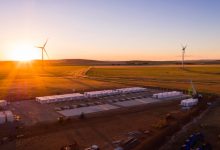South Australia – already leading the world in the uptake of wind and solar and operating its grid at high levels of renewables – could be the first gigawatt scale grid in the world to operate without synchronous generation.
The possibility has been flagged by the Australian Energy Market Operator in one of a series of stakeholder briefings that canvass the changes to technology and operating procedures that were once unimaginable, and for some energy people still are.
South Australia is unique in the world because it is the first gigawatt scale grid to operate at such high levels of wind and solar, which in the past year have accounted for 64 per cent of local generation, according to AEMO.
It’s also unique because – apart from closing the last of its two coal generators six years ago – it also runs this high level of renewables without hydro, or geothermal. And the big challenge now is how to remove the need for the remaining fossil fuel generators, which are primarily gas with some diesel.
It will take some time to do away with all gas and diesel because until enough wind and solar and storage is built – be it from batteries, pumped hydro or even hydrogen – those fossil fuels will be needed to supply power in the case of wind and solar droughts.
But AEMO is also looking to run the grid at times with no synchronous generators, meaning no fossil fuels. Up until recently, at least four gas units were required to be online even if there was enough wind and solar to meet local demand.
The installation of four synchronous condensers – spinning machines that do not burn fuel – means that that requirement has been reduced to just two gas generating units, operating at very low combined capacity of 80MW. Sometimes that’s a mere fraction, less than five per cent, of the amount of generation.
The next step is to reduce the need for those two gas generators to be needed at such times. The answer will come with either more syncons, or more preferably, inverter technologies capable of providing “grid-forming” services, meaning that they can provide the system strength and inertia needed to maintain grid security.
“Initial desktop studies for grid formation and grid reference show (the) SA system could be theoretically capable of ‘holding together’ without synchronous generators,” AEMO writes in an newly published presentation made to stakeholders earlier this month.
“Further desktop studies and real time tests (are) required as this is (a) world-first operation,” it adds.
Indeed, it would be. Some of the South Australia batteries – such as Dalrymple North and the expansion of the Hornsdale Power Reserve – can offer “grid forming” inverter technologies.
But AEMO, and the state governments, will want to see this tested at scale, hence the recent launch of a new $100 million funding round by the Australian Energy Market Operator to assist at least three new big batteries that provide “grid forming” capabilities as a core part of their offering.
That funding is provided because there is not yet any market that recognises these offerings, one of the many tasks on the “to-do” list of Australian energy market reforms.
AEMO’s presentation notes that it is considering options such as contracts and market services to meet some of those power system requirements.
“Further studies to be done to determine if other system requirements can be met through alternative arrangements,” it says.
AEMO has had to rely on direct contracts, or substantial grant funding from the likes of ARENA, for many of the landmark battery projects, such as Dalrymple, Hornsdale, and the Victoria Big Battery, currently the biggest battery installation in Australia that has been allowing the main link between Victoria and NSW to operate at or near full capacity.
It notes that if it does move to a system with no synchronous generators, then the so called “operating envelope” will have to change.
This includes the amount of electricity that can be exchanged through the major transmission links at any one time. It warns that the prevalence of rooftop solar and other distributed resources – rooftop solar can, on occasions, meet nearly all of state demand – makes the transition even more complex.
AEMO expects to be able to provide updates on the findings of its desk top analysis and plans for the next steps by the middle of the year.
What is discovered in South Australia will be crucial for the rest of the Australian grid, which is expected to follow quickly down the path of closing coal, and lifting the share of renewables to a very high level.
Other states, however, will likely benefit from having existing hydro facilities and multiple links with other states that will also provide a cushion for energy security.










